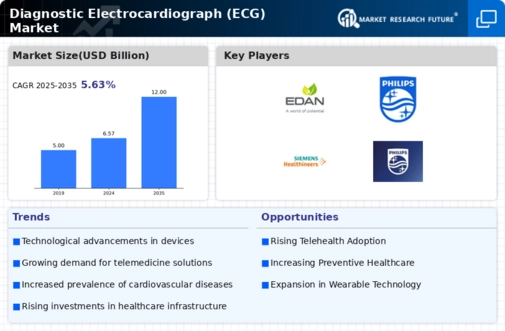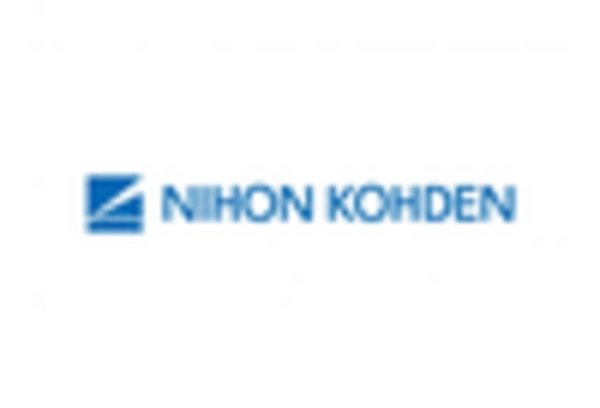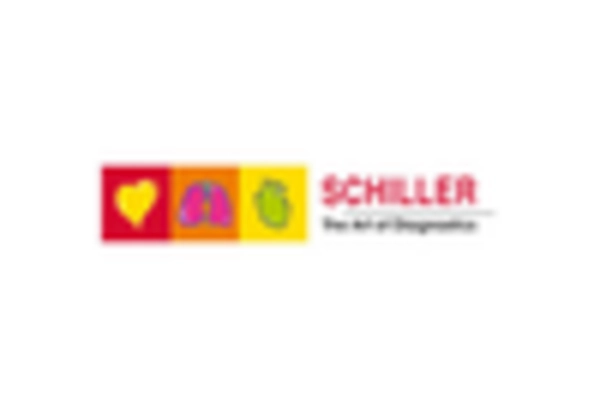Growing Geriatric Population
The increasing geriatric population is a significant factor driving the Diagnostic Electrocardiograph Market (ECG) Market. As individuals age, the risk of developing cardiovascular diseases escalates, leading to a higher demand for effective monitoring solutions. The World Health Organization has projected that the number of people aged 60 years and older will double by 2050, highlighting the urgent need for healthcare systems to adapt. This demographic shift is likely to result in a surge in the utilization of ECG devices, as older adults require regular cardiac assessments. Additionally, healthcare providers are increasingly focusing on preventive care for the elderly, further boosting the demand for diagnostic tools. Thus, the Diagnostic Electrocardiograph Market (ECG) Market is expected to experience substantial growth driven by the needs of this expanding population segment.
Increased Focus on Preventive Healthcare
The rising emphasis on preventive healthcare is shaping the Diagnostic Electrocardiograph Market (ECG) Market. As healthcare systems worldwide shift towards proactive measures, the demand for diagnostic tools that facilitate early detection of health issues is growing. ECG devices are integral to this approach, enabling healthcare providers to monitor patients' heart health and identify potential problems before they escalate. This trend is supported by various health initiatives aimed at promoting regular health screenings and awareness campaigns. Furthermore, the integration of ECG monitoring into routine check-ups is becoming more common, reflecting a broader commitment to preventive care. Consequently, the Diagnostic Electrocardiograph Market (ECG) Market is likely to benefit from this paradigm shift, as more individuals seek out ECG services as part of their health management.
Technological Innovations in ECG Devices
Technological advancements in ECG devices are significantly influencing the Diagnostic Electrocardiograph Market (ECG) Market. Innovations such as portable ECG monitors, wireless connectivity, and advanced software algorithms are enhancing the functionality and user-friendliness of these devices. The integration of artificial intelligence and machine learning into ECG analysis is also emerging, allowing for more accurate interpretations and timely alerts for healthcare providers. As a result, the market is witnessing a shift towards more sophisticated and efficient ECG solutions. The introduction of smartphone-compatible ECG devices is further expanding the consumer base, making heart monitoring accessible to a wider audience. This trend indicates a promising future for the Diagnostic Electrocardiograph Market (ECG) Market, as technology continues to evolve and meet the demands of both healthcare professionals and patients.
Rising Prevalence of Cardiovascular Diseases
The increasing incidence of cardiovascular diseases is a primary driver for the Diagnostic Electrocardiograph Market (ECG) Market. As heart-related ailments continue to rise, healthcare providers are compelled to adopt advanced diagnostic tools to enhance patient outcomes. According to recent statistics, cardiovascular diseases account for a substantial percentage of global mortality rates, necessitating effective monitoring and diagnosis. This trend is likely to propel the demand for ECG devices, as they play a crucial role in early detection and management of heart conditions. Furthermore, the growing awareness among patients regarding heart health is expected to contribute to the market's expansion, as individuals seek regular check-ups and monitoring solutions. Consequently, the Diagnostic Electrocardiograph Market (ECG) Market is poised for significant growth in response to these pressing health concerns.
Regulatory Support for Advanced ECG Technologies
Regulatory bodies are increasingly supporting the development and adoption of advanced ECG technologies, which is positively impacting the Diagnostic Electrocardiograph Market (ECG) Market. Stricter regulations regarding the safety and efficacy of medical devices are prompting manufacturers to innovate and improve their offerings. This regulatory focus not only ensures that patients receive high-quality diagnostic tools but also encourages investment in research and development. As a result, the market is witnessing the introduction of cutting-edge ECG devices that meet stringent regulatory standards. Additionally, favorable reimbursement policies for ECG services are further incentivizing healthcare providers to incorporate these technologies into their practices. This supportive regulatory environment is likely to foster growth within the Diagnostic Electrocardiograph Market (ECG) Market, as stakeholders seek to capitalize on emerging opportunities.


















Leave a Comment